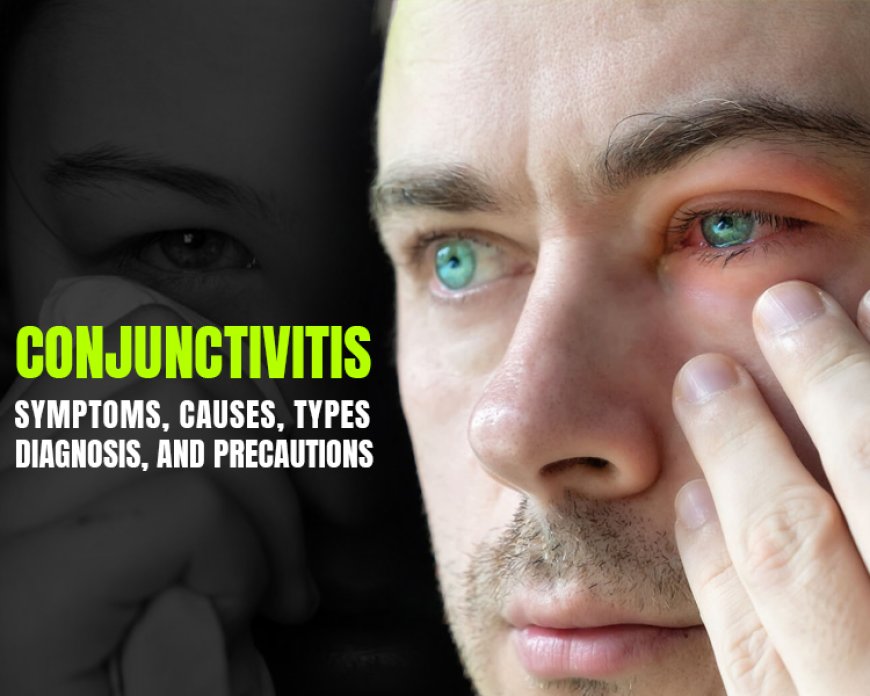Conjunctivitis: Symptoms, Causes, Types, Diagnosis, and Precautions
Learn all about conjunctivitis - from symptoms and causes to different types, diagnosis methods, and precautions. Also, learn how to identify and manage this common eye condition with expert advice and helpful tips. Protect your eyes and find relief from conjunctivitis with our comprehensive guide.

Conjunctivitiis a very contagious eye condition that affects the thin, clear tissue covering the white part of the eye and the inside of the eyelids. This condition can happen for different reasons and shows up with different signs. In this blog, we will talk about conjunctivitis, also known as pink eye. We will discuss the signs and symptoms, what causes it, the different types, how it is diagnosed, and some important things you can do to manage and prevent it from spreading.
Symptoms of Conjunctivitis:
- When the white part of your eye and the inside of your eyelids look red.
- Eyes producing watery or thick, yellowish fluid.
- Feeling like your eyes are itchy or have something in them that makes them feel rough.
- Puffiness of the eyelids.
- Becoming more sensitive to bright lights.
- Difficulty seeing clearly.
- When you wake up, you might notice that your eyelashes have some crusty stuff on them.
Causes of Conjunctivitis:
Viral conjunctivitis: Viral conjunctivitis is an infection that affects the clear layer of tissue covering the white part of the eye and the inner surface of the eyelids. Often caused by viruses that are similar to the ones that cause the common cold. It can easily spread from person to person through coughing, sneezing, or touching things that an infected person has touched.
Bacterial Conjunctivitis: An eye infection caused by bacteria. It can spread when you touch someone who is infected or touch objects that have the bacteria on them.
Eye Allergies: When your eyes get irritated and inflamed because of things like pollen, pet fur, or dust mites that you're allergic to.
Chemical conjunctivitis: This happens when your eyes are exposed to things that can irritate them, like smoke, fumes, or chlorine in swimming pools.
Types of Conjunctivitis:
1. Pink eye: Pink eye, also called conjunctivitis, is a type of eye infection that happens suddenly and doesn't last very long. It's usually caused by viruses or bacteria.
2. Persistent Eye Inflammation: Lasts for a longer time and can be caused by ongoing bacterial or allergic reactions.
3. Eye Allergies: Caused by things you're allergic to, which make your eyes itchy, red, and watery.
4. Big Bumps on Eyelids from Wearing Contact Lenses: This condition, known as Giant Papillary Conjunctivitis (GPC), happens when you wear contact lenses and causes large bumps to form on the inside of your eyelids.
Diagnosis of Conjunctivitis:
It's really important to see an eye doctor to get the right diagnosis and treatment. The doctor will check your eyes and ask about any problems or if you've been around anything that could have caused irritation or infection. Sometimes, a sample may be taken from the affected area using a swab. This sample is then sent to a laboratory for testing to find out what is causing the problem.
Precautions and Management:
Keeping Your Hands Clean: Remember to wash your hands with soap and water often, especially after touching your eyes or the area around them.
Don't Touch or Rub Your Eyes: Try not to touch or rub your eyes to avoid spreading infections.
Your Personal Stuff: Don't use the same towels, pillowcases, or eye makeup as other people to prevent spreading germs.
Contact Lenses: If you wear contact lenses, make sure to keep them clean and follow the instructions for how often to replace them. It's important to take good care of your lenses to keep your eyes healthy.
Avoiding Allergens: Find out what things are causing your eye irritation and try to stay away from them.
Medication: Take antibiotics or antiviral medications as directed by your doctor to treat bacterial or viral conjunctivitis, respectively.
A warm compress is when you apply something warm, like a heated towel or a warm water bottle, to a specific area of your body. Putting a warm cloth on the affected area can make it feel better and help reduce the hardening of any crusts.
If you think you have pink eyes or your eyes are bothering you for a long time, make sure to see a doctor as soon as possible. It's important to catch and treat a problem early on to avoid any complications and help you get better quickly.
Conclusion:
Conjunctivitis is an eye condition that can make your eyes feel uncomfortable and can easily spread to other people. However, if you know about it, take the right steps to protect yourself, and get medical help when needed, you can reduce its effects. Remember to keep yourself clean and take steps to protect your eyes and stay healthy.
What's Your Reaction?


















































